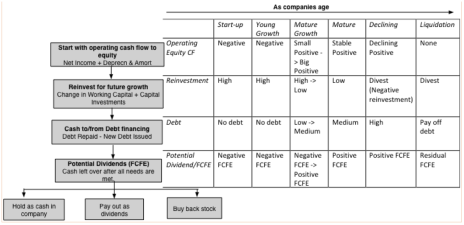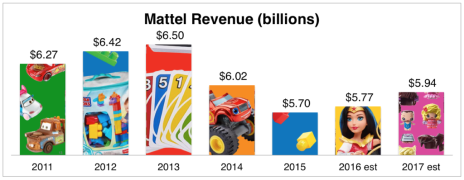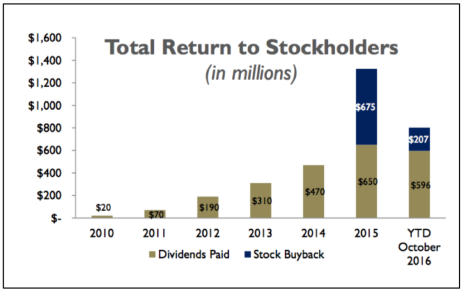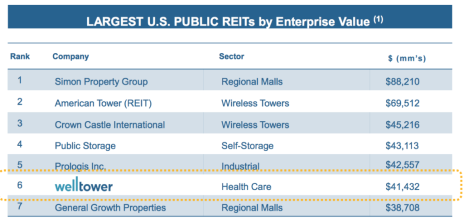[You can find the most recently updated list of stocks here.]
Most of the stocks in the S&P 500 pay a dividend—417 of them. But only 42 of those qualify as High Dividend Stocks, with yields over 4%. And only 10 S&P companies have a dividend yield over 5%. These 10 highest paying dividend stocks in the S&P 500 yield between 13% and 5%. I’ll take a closer look at all of them in a minute, but first, here’s the list.
Highest Paying Dividend Stocks in the S&P 500
- Frontier Communications Corp. (FTR)
- CenturyLink (CTL)
- Iron Mountain (IRM)
- Mattel (MAT)
- Pitney Bowes (PBI)
- Host Hotels & Resorts (HST)
- Welltower (HCN)
- Seagate Technology (STX)
- Staples (SPLS)
- Ventas (VTR)

Get My Free Report Now

Get My Free Report Now

Get My Free Report Now

Get My Free Report Now
The rest of the S&P’s 42 high dividend stocks yield less than 5% but more than 4%.
Here are the top 15, sorted by highest yield:
- Entergy (ETR)
- HCP (HCP)
- Verizon (VZ)
- AT&T (T)
- Ford Motor (F)
- First Energy (FE)
- Kohl’s (KSS)
- The Southern Company (SO)
- Macy’s (M)
- Occidental Petroleoum (OXY)
- ONEOK (OKE)
- Kimco (KIM)
- Duke Energy (DUK)
- PPL Corporation (PPL)
- Extra Space Storage (EXR)
You might notice some commonalities among these high yielders. There are several REITs, in both the top 10 and next 15. The 4% to 5% yielders include a couple of utilities and several energy companies, but there aren’t any in the top 10. The two largest U.S. telecoms, Verizon and AT&T, both make the list. So do a couple of retailers, which have a unique feature in common. In fact, this feature is common to almost all of the top 10 high yielders except the REITs.
Here’s a closer look at each one of the top 10 highest paying dividend stocks by yield.
- Frontier Communications (FTR) – Dividend Yield: 13%
As I mentioned, many of the highest yielding stocks in the S&P—including the top three—have something in common. They’re all in industries that are, frankly, declining. Top-yielding Frontier Communications (FTR) and number-two-yielder CenturyLink (CTL) are both landline telephone companies. Companies that are shrinking can—and should—return more of their earnings to investors, because they’re no longer investing in the business. While the business life cycle gets less attention than the better-known product life cycle, it’s equally real. The following table was created by NYU Stern Professor Aswath Damodaran, and shows the potential dividends available to investors at each stage of the business life cycle.
- CenturyLink (CTL) – Dividend Yield: 9%
CenturyLink is also a landline telecom, and like Frontier, its stock peaked years ago. CenturyLink’s revenues are also past their prime, their last peak was in 2012. But the company is cutting costs faster than revenues are shrinking, so earnings per share are actually growing! And since the company doesn’t need to invest in growing the business, it can return most of its cash to investors. CenturyLink’s dividend payout ratio is 127%, which is way too high for most companies—they’re giving all their profits and then some to investors! But for CenturyLink it’s just the right level.
- Iron Mountain (IRM) – Dividend Yield: 6%
Iron Mountain was founded at the height of the cold war to securely store documents underground. The company still stores plenty of important original documents, like film reels and sheet music, but business declined as paper was replaced by digital records. Revenue is fairly steady today, and the company has reorganized as a REIT so it can more easily return most of its cash to investors—the current dividend payout ratio based on EPS is over 800%.
- Mattel (MAT) – Dividend Yield: 5.9%
Mattel is the highest yielding of the next group of high dividend stocks, the 5-plus-percenters. Toys aren’t a traditionally high-yielding industry—Mattel’s operating margins are less than 10%—but the stock is cheap because revenues and earnings have been falling since 2013. Barbie’s sales started falling in 2012, and then Mattel lost the license to Disney’s “Princess” dolls at the end of 2015. There have been some big structural shifts in the toy industry—entertainment drives more and more toy sales, for example—but it’s not disappearing like landlines or paper documents. Mattel’s management is working on a turnaround, and though it’s taking longer than expected, analysts finally expect revenue and earnings growth to return this year. In the meantime, MAT yields 5.9%, and though the dividend payout ratio is currently unsustainably high, it should decline as earnings rebound.
- Pitney Bowes (PBI) – Dividend Yield: 5.7%
Pitney Bowes was founded as the Pitney Bowes Postage Meter Company in 1920. The company eventually expanded to offer copiers, Dictaphones and barcode equipment as well as postage machines. But like Iron Mountain, Pitney Bowes saw demand for its products and services dry up as the world went digital. The stock peaked in 1999 and has been declining ever since. But it still pays a dividend, which yields over 5%.
- Host Hotels & Resorts (HST) – Dividend Yield 5.4%
Host Hotels is a real estate investment trust (REIT) that owns hotels and resorts, including the Marriott, Westin and Ritz-Carlton brands. Management has a dual mandate to return capital to shareholders while also adding to cash flow by reinvesting in properties and making acquisitions. Funds from operations, the best measure of REIT earnings, have grown steadily each year since 2010. At the same time, management has returned over $3.2 billion to shareholders through dividends and stock buybacks (which are done when HST is trading at a discount to its net asset value)—see chart below. Management has also successfully reduced leverage from 5.3x in 2009 to 2.8x in 2015.
- Seagate Technology (STX) – Dividend Yield 5.3%
Ireland-based Seagate Technology makes hard drives and other data storage solutions. Hard drive demand is declining as disc drives are replaced by faster, smaller solid-state drives. Seagate’s revenues are declining, slowly, as well. However, the company is staying afloat, reducing operating expenses and buying back shares to support EPS. And they’re returning plenty of cash to shareholders. Over the past five years, Seagate’s annual dividend increases have averaged 70% per year!
- Welltower (HCN) – Dividend Yield: 5.3%
The sixth-largest public U.S. REIT, Welltower owns a large health care-focused real estate portfolio. The company’s thousand-plus properties fall into three categories: senior housing, post-acute care centers and outpatient centers. They focus on private-pay customers and on keeping patients out of more expensive hospital settings. Demand is benefiting from the dual trends of the aging U.S. population and the fight to keep health care costs down. Funds from operations have increased by an average of 6% per year since 2011. The company has paid dividends since 1992, and increases the dividend by about 5% per year (10 year average).
- Staples (SPLS) – Dividend Yield: 5.2%
The highest paying dividend stocks list is starting to look like a virtual graveyard of copiers, hard drives and other outdated business equipment. Staples, of course, is the office superstore, and while people are still shopping there, revenues and margins have been declining since 2012. The stock also peaked at the end of 2012. And dividends have been flat since 2014.
- Ventas (VTR) – Dividend Yield 5.0%
Ventas rounds out our top 10 highest dividend payers with one more REIT. Like Welltower, Ventas specializes in health care facilities. The company’s portfolio is more diverse than Welltower’s, with over 760 senior housing centers, 371 medical office buildings, 66 skilled nursing facilities, 50 hospitals and 23 life science centers. Operating cash flow increased steadily from 2011 to 2015, but stumbled slightly in 2016. But management has increased the dividend every year since 2011, by an average of about 8% per year.
The yields offered by Host Hotels & Resorts (HST) and Welltower (HCN) are high and sustainable. But owning REITs has some tax consequences, so investors should read our free guide to real estate investment trusts to see if they’re right for you.
To find out my favorite stock from the 10 highest paying dividend stocks in the S&P, consider taking a trial subscription to Cabot Dividend Investor.








